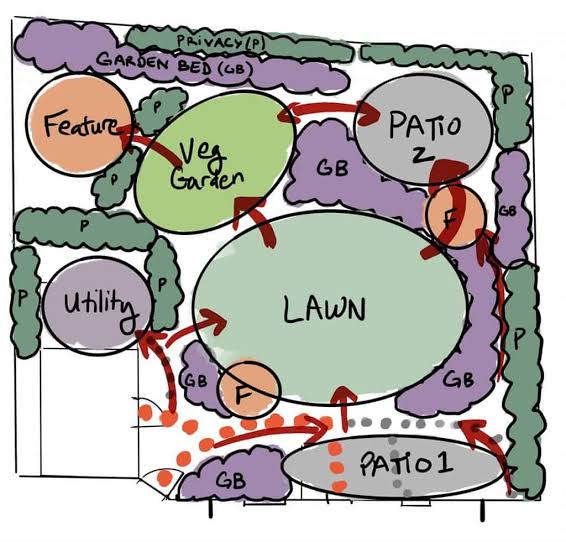If you dream of creating a lush, organized, and beautiful garden — whether it’s a small backyard plot or a spacious homestead — then mastering your garden planning layout is the key to success. A smart layout transforms your outdoor space into a productive, peaceful, and visually stunning oasis.In this guide, you’ll discover expert tips, clever hacks, and practical ideas to design a garden layout you’ll absolutely love — no matter your space or experience level. Let’s dive in! 🌸🌼 Why Garden Planning Layout MattersYour garden layout is more than just where you place your plants — it’s the foundation of a thriving garden. A well-planned layout helps you:🌱 Maximize space — every inch of soil can serve a purpose.💧 Improve watering efficiency — no more dry patches or soggy spots.🌸 Enhance beauty & balance — for a garden that looks as good as it grows.🌿 Simplify maintenance — better paths, access, and organization.🌞 Optimize sunlight — placing plants right where they’ll thrive.So if you love garden planning layout, get ready — these pro secrets will help you create a stunning and functional garden space.🏡 Step 1: Assess Your Garden SpaceBefore sketching your dream layout, take a walk around your garden. Observe:☀️ Sunlight patterns: Which areas get full sun, partial shade, or full shade?🌬️ Wind direction: Protect delicate plants with fences or shrubs.💧 Drainage: Avoid placing water-sensitive plants in low-lying areas.🪴 Soil type: Sandy, loamy, or clay? Adjust with compost as needed.Hack Inside! 🌿Mark these zones on paper (or a garden planner app) to visualize where different plants will perform best.🌷 Step 2: Choose Your Garden StyleYour garden layout should match your lifestyle and aesthetic. Popular design styles include:🌼 Cottage GardenA mix of flowers, herbs, and veggies — informal, colorful, and charming.🌻 Raised Bed GardenPerfect for small spaces or poor soil. Easier to manage, weed, and water.🌾 Formal GardenSymmetrical lines, trimmed hedges, and neatly arranged flowerbeds for elegance.🪻 Modern Minimalist GardenClean lines, structured plants, and plenty of open space.Hack Inside! 🪴Combine function and style — for example, raised vegetable beds bordered by ornamental flowers add both beauty and productivity.🌿 Step 3: Divide Your Garden Into ZonesA good garden planning layout organizes your space into functional zones:🥕 Vegetable garden area🌸 Flower beds and borders🍋 Herb or kitchen garden🌳 Fruit trees or shrubs🌻 Relaxation or seating space🚶♀️ Paths and walkwaysHack Inside! 🪴Use gravel, stepping stones, or mulch to clearly define each zone while keeping your garden tidy and accessible.🌼 Step 4: Plan for Plant CompatibilityNot all plants make good neighbors! Group plants with similar needs together — this makes watering and maintenance much easier.Example:Tomatoes, basil, and peppers love full sun and frequent watering.Lavender, rosemary, and sage prefer drier soil and plenty of light.Hack Inside! 🌿Use companion planting to boost growth naturally — for example, marigolds deter pests near vegetables, while basil enhances tomato flavor.🌞 Step 5: Think About Sunlight and ShadeSun exposure affects everything in your garden.Full sun (6+ hours): Tomatoes, peppers, sunflowers.Partial sun (3–6 hours): Lettuce, spinach, carrots.Shade (less than 3 hours): Ferns, hostas, and hydrangeas.Hack Inside! ☀️Orient rows north to south so all plants receive equal sunlight throughout the day.🧱 Step 6: Include Walkways and BordersWell-designed paths make your garden easier to navigate and maintain.Try these materials:Gravel or stone for rustic charmBrick for a traditional lookWood chips for natural appealHack Inside! 🪴Add curved paths for visual flow and raised borders to prevent soil erosion and define spaces beautifully.🌺 Step 7: Add Vertical ElementsRunning out of space? Go vertical!Use:Trellises for climbing plants (beans, peas, or cucumbers)Hanging baskets for flowersWall planters for herbsHack Inside! 🌸A vertical herb garden near your kitchen door saves space and keeps fresh ingredients within reach!🌳 Step 8: Plan for All SeasonsTo keep your garden lively year-round, choose plants with different blooming times:🌸 Spring: Tulips, daffodils, pansies🌼 Summer: Zinnias, sunflowers, marigolds🍁 Autumn: Mums, asters, ornamental grasses🌲 Winter: Evergreen shrubs or hollyHack Inside! 🍂Mix perennials (long-lasting plants) with annuals (seasonal flowers) for a balance of reliability and color.💧 Step 9: Smart Watering SolutionsSave time and effort by planning your watering system early.Use drip irrigation for efficient watering.Install rain barrels to collect natural water.Group thirsty plants closer together for easy maintenance.Hack Inside! 💧Add a mulch layer around your plants — it retains moisture, suppresses weeds, and keeps your garden looking polished.🌸 Step 10: Add Personality and CharmNow for the fun part — making your garden yours!🪴 Add garden décor like fairy lights, lanterns, or sculptures.🪑 Create a cozy seating nook with a bench or hammock.🐦 Attract wildlife with bird feeders or butterfly plants.Hack Inside! 🕯️Group decorative elements in odd numbers (3 or 5) — it creates a more natural, balanced look.🌿 Bonus: Tools for Planning Your Garden LayoutIf you love digital tools, try these free garden planners:Garden Planner by Better Homes & GardensSmart GardenerGrowVeg Garden PlannerThey help you visualize your layout, track plant care, and plan crop rotations easily.🌷 Conclusion: Create the Garden of Your DreamsA well-designed garden planning layout blends beauty, productivity, and balance. With the right structure, thoughtful plant choices, and a few creative touches, you can create an outdoor sanctuary that thrives through every season.Whether you’re growing vegetables, flowers, or simply designing a peaceful retreat, these secret garden planning tips will guide you every step of the way.So grab your notebook (or garden planner app), sketch your dream space, and let your imagination bloom — your perfect garden awaits! 🌿🌸✨

